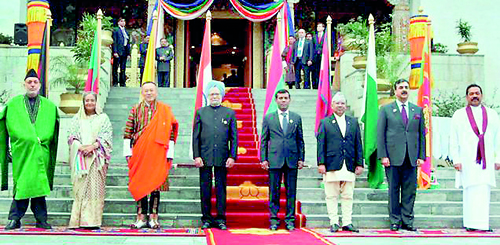Sunday Times 2
SAARC anthem to celebrate our South Asianness
Fostering regional consciousness needs mammoth efforts. South Asia has a formal mechanism of cooperation in place among its member countries through the vibrant organisation of the South Asian Association for Regional Cooperation (SAARC). I visited foreign ministries and foreign service institutes of South Asian countries in 2004-2005. Those days the idea of deeper interaction among the South Asians always brought back memories of my days spent in Jawaharlal Nehru and Delhi Universities. I cherished the company of students from the South Asian countries who enriched my academic life in many ways.
The visit gave me the opportunity to meet young Bangladeshi, Nepali and Sri Lankan officer-trainees. During our meetings we felt that it would be a great learning experience for the young officer-trainees of the SAARC countries if we could spend a week or so together and share our ideas and aspirations with each other.

SAARC leaders at the Bhutan summit in 2010. Pic courtesy PTI
After my visit to Nepal, Bangladesh and Sri Lanka, I wrote a paper titled ‘South Asian Affairs’ proposing a South Asian University in 2005, I was glad to see that the establishment the new South Asian University was announced later that year in Dhaka at the 13th SAARC Summit, though it may not have been possibly because of my paper. The South Asian University is functioning since 2010 at Akbar Bhawan, New Delhi paving the path for a new South Asia.
After the milestone achievement in the history of SAARC with the establishment of the South Asian University, I believe a SAARC anthem, a song that all South Asians could sing together, can act as a catalyst in fostering deeper South Asian consciousness and fraternity. I am now ready with a SAARC anthem after a warm and enthusiastic reception of the Earth Anthem internationally which I wrote and produced recently.
The Earth Anthem was released in June this year by Kapil Sibal and Shashi Tharoor, Union Ministers of India at ICCR, New Delhi and later in Kathmandu by Jhalanath Khanal, former Prime Minister of Nepal in the presence of Axel Plathe, UNESCO’s Representative to Nepal. Since then it has been translated into major world languages. The Central Board of Secondary Education (CBSE), India has put this on its website for the use of the students studying in schools affiliated with CBSE. I have been informed that UNESCO is going to turn the idea of an official Earth Anthem into a global initiative. I hope a Global Earth Anthem Challenge will be launched soon and the best judged entry will be declared as the official anthem of our planet earth.
Regional and international anthems have been in use since quite some time now. Some of the other prominent regional organisations have their own anthems. For example the European Union uses ‘Beethoven’s Symphony No. 9 (Ode to Joy part)’ as its anthem while the African Union has adopted its own anthem titled ‘Let’s All Unite and Celebrate Together’. The Association of South East Asian Nations (ASEAN) has adopted an official anthem titled ‘ASEAN Way’ in 2008 which is in English. As per ASEAN, its anthem is an expression of ASEAN unity and strengthens the sense of ASEAN identity and belonging among the peoples of the region.
Being aware of the huge popularity of Bollywood films in South Asia, I have written an anthem for SAARC in a mix of nine languages spoken and understood in the South Asian countries-
South Asian Anthem – Multilingual (9 Languages)
Himalaya theke Hinda Sagor, Naga Hills theke Hindukush (Bangla)/Mahaweli inn Ganga, Sindhu inn Brahmputra (Dhivehi)/Lakshadweep, Andaman, Everest, Adam’s Peak (English)/Kabul Lay Thimphu Tsuen, Male Lay Kathmandu (Dzongkha)/Dilli sita Dhaka, Colombin, Islamabad (Sinhala)/Harek paila saath-saath, Harek paila saath-saath (Nepali)/Dzongkha, Hindi, Nepali,Bangla, Pashto, Sinhala (Pashto)/Urdu, English, Dhivehi, Har kadam saath-saath, Har kadam saath-saath/Apni-apni pehchan, apne-apne arman (Urdu)/Shanti ki baat-baat, Har kadam saath-saath (Hindi)/Har kadam SAARC saath, Har kadam saath-SAARC/Har kadam SAARC saath, Har kadam saath-SAARC.
Naga and Chin hills mark the eastern frontiers of SAARC member states. Mahaweli is the longest river of Sri Lanka while Adam’s Peak is its most venerated peak. Sri Lanka has two official languages — Sinhala and Tamil like Afghanistan which also has two official languages –Pashto and Dari. I have chosen the language of their national anthems. Dhivehi is the official language of Maldives.
This is to inspire the SAARC Secretariat to launch a competition in all SAARC Member countries and declare the best judged entry as the official SAARC anthem. Once adopted, the official SAARC anthem could be encouraged at the formal meetings of SAARC as well as SAARC apex and recognized bodies. It could also be played to commemorate special occasions of SAARC such as the SAARC Charter Day (8 December).
SAARC member countries could be encouraged to produce the official SAARC anthem into local languages as a way to promote the anthem and foster South Asian consciousness and fraternity among their citizens.
The writer is a poet and winner of the SAARC Literary Award.

